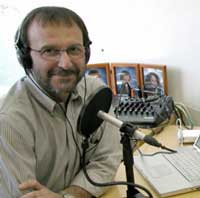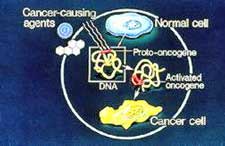Dr. Racaniello and Dr. Bateman talked XMRV (mostly) at the CFID’S Association Webinar on Wednesday.
 DR. RACANIELLO gave us a bird’s eye of retroviruses. Right now there are two models for human infectious retroviruses; HIV, which replicates madly in immune cells and sends millions of virions into the blood to infect more cells and HTLV-1, which does not replicate much and does it’s damage by turning on bad genes in the cells it is found in (sometimes turning them cancerous).
DR. RACANIELLO gave us a bird’s eye of retroviruses. Right now there are two models for human infectious retroviruses; HIV, which replicates madly in immune cells and sends millions of virions into the blood to infect more cells and HTLV-1, which does not replicate much and does it’s damage by turning on bad genes in the cells it is found in (sometimes turning them cancerous).
He noted that XMRV, at this point, seems more HTLV-like – it’s present in small numbers in the blood and doesn’t appear to be replicating much.
 (This could be misleading, however. XMRV could be replicating madly in some other part of the body. We know that the immune cells contain APOBEC3 enzymes that ‘edit’ XMRV sequences – thus largely shutting it’s replication down but that prostate cells do not contain this enzyme allowing XMRV to replicate in them. Primate studies of XMRV indicate that XMRV infects many cells – it uses a receptor commmonly found on cells to enter them – and that, upon infection it spreads rapidly throughout the body. It could be flourishing in areas of the body that have not been studied yet).
(This could be misleading, however. XMRV could be replicating madly in some other part of the body. We know that the immune cells contain APOBEC3 enzymes that ‘edit’ XMRV sequences – thus largely shutting it’s replication down but that prostate cells do not contain this enzyme allowing XMRV to replicate in them. Primate studies of XMRV indicate that XMRV infects many cells – it uses a receptor commmonly found on cells to enter them – and that, upon infection it spreads rapidly throughout the body. It could be flourishing in areas of the body that have not been studied yet).
(XMRV, then, could look like HTLV-1 in the blood but like HIV elsewhere.) This is an important question because its mode of action determines how easy it is to treat. It took years to learn how to treat HIV but eventually, for those able to get the drugs, it’s eminently treatable because the stages of the replicative process give researchers different shots at it. You don’t need to kill HIV to get better – you just need to stop it from replicating.
Oncogenes for XMRV?HTLV-1, on the other hand, effects the body simply by being present in the cell because it appears to turn on genes in the cell that can cause the cell to become cancerous. Stopping this type of virus presumably requires killing all the cells it is present in, which is very difficult to do.
(One study that looked at XMRV’s effects on genes in the cell did not find found that it inserted in areas of the genome where it could turn on ‘oncogenes’; ie genes that turn cells cancerous. XMRV, on the other hand, could trigger an immune response in some individuals simply by being in the cell. Or, as noted earlier, XMRV could be acting like HIV in a different part of the body – which is the preferable scenario, oddly enough, treatment wise.)
Why the varying study results? Dr. Racaniello laid out four possible reasons and emphasized the last; patient selection/geographic differences in viral prevalence/ sequence differences in viruses in different regions and the lack of standardized testing. He noted that, with regards culturing the virus for PCR, that that was not done in the original Science paper and that the validation studies have, in general, followed the approach taken in that paper. If culturing is necessary to find the virus via PCR he urged WPI researchers to publish that information.
Time – He also noted that finding the correct treatment takes time. HIV was isolated in 1984. It took about a year to develop the first antibody test. AZT was not discovered until 1989 and the HAART therapy that has proved so effective became available in 1995, after over ten years of intense scientific effort. (Dr. Klimas and others believe that the process could be sped up significantly with XMRV)
DR. BATEMAN – Dr. Racaniello was clearly comfortable at the mike in a kind of low key way. Dr. Bateman, on the other hand seemed almost effervescent in comparison. She’s not always so enthusiastic but for whatever reason she seemed to be enjoying herself immensely this time. She is deeply involved in the Light/Singh study and hoped to be able to provide some information on it by now, but alas, could not. Her talk, however, was very engaging.
No ‘True CFS’ At the Clinic – Dr. Bateman is known for her careful analysis of her CFS and FM and idiopathic fatigue patients and she demonstrated her ability to differentiate different types of patients in in spades in her talk. Knowing that stating so was going to tick off some people she declared that there is no ‘true CFS’ – that what we have, at the moment, are a bunch of educated guesses.
Interestingly she noted that the broad range of patients she sees at her ‘Fatigue Consultation Clinic’ fit the (dreaded) Empirical Definition more than anything else; that is, she sees a lot of different patients and some of them fit the Fukuda criteria and some fit the Canadian Consensus Criteria but all of them fit the Empirical Definition. These are the broad range of ‘idiopathic fatigue’ patients that doctors see. They are all sick, they have all presumably seen many doctors in their search for an answer. These are the 4 million or so really fatigued people in the US that the medical profession simply does not have an answer for. (If the CDC and Dr. Jason’s studies are correct then about 50% of them have not seen a doctor for their problems; that leaves about 2 million people in in the US who have seen a doctor for their condition; most of whom have probably gotten no relief).
Dr. Bateman did note that the Empirical Definition does appear to allow in more depressed patients. She was speaking as a clinician not a researcher and she did not endorse the Empirical Definition as a study tool.
 (As an aside, the Empirical definition casts a wide net and it does, as Dr. Bateman indicated, it may very well pick up the broad class of patients with mysterious fatigue that doctors see at the office. As such it could be an effective way to find these people and then break them up into their constituent subsets. Except for one study the CDC, however, never chose to attempt to attempt to do that in a meaningful way – instead, they simply proclaimed that they were all just CFS patients. Not attempting to subset these patients, was, as you’ll see as you follow Dr. Bateman, a huge missed opportunity. Then, again, the CDC hasn’t been particularly interested in ME/CFS physicians opinions.)
(As an aside, the Empirical definition casts a wide net and it does, as Dr. Bateman indicated, it may very well pick up the broad class of patients with mysterious fatigue that doctors see at the office. As such it could be an effective way to find these people and then break them up into their constituent subsets. Except for one study the CDC, however, never chose to attempt to attempt to do that in a meaningful way – instead, they simply proclaimed that they were all just CFS patients. Not attempting to subset these patients, was, as you’ll see as you follow Dr. Bateman, a huge missed opportunity. Then, again, the CDC hasn’t been particularly interested in ME/CFS physicians opinions.)
Check out the different types of ‘CFS patients’ who end up at her office.
* The In-betweeners – these are people in the early stages of multiple sclerosis, autoimmune diseases, neurologic conditions, etc. who don’t quite fit the criteria for those diseases but get shoved into the CFS basket until they do.
* The Misdiagnosed – these are people who have a condition that physicians have missed. She described one woman in her late 60s with horrible fatigue and exercise intolerance who was suffering from coronary artery disease and having a bad reaction to Cymbalta.
* The Complex CFS Cases – these are people who have CFS but also have a host of other problems – which make it difficult to tell what is causing what. She related a disturbing story of a skinny 15-year-old who returned to her office several decades later, severely obese, with chronic dental and other infections, poorly controlled diabetes and sleep apnea. She asked – should this person, with all her problems, be in a CFS study?
* The fluey, pathogen ridden, immune system blasted subset – The original definition of CFS in the US, the Holmes definition, focused on the sudden onset, flulike symptom, natural killer cell reduced group. She noted that this group in appears to have different gene expression findings than the other groups. Is this true CFS?
* Postexertional Malaise Group – the above group may sound like CFS but, if Dr. Bateman was to chose any group to represent CFS, she would choose the group of people (presumably without another comorbid conditions like diabetes) that suffer relapses after exercise.
* Cognitively Challenged Group – is cognitive dysfunction required to meet the definition of chronic fatigue syndrome? Some people think so and some people don’t. This is not a prominent feature for everyone.
The Onset Question – And what about onset? Dr. Bateman noted that there are several types of onset
* The EBV (infectious mononucleosis) during Adolescence group appears to be different from other groups. They tend to have postural orthostatic tachycardia syndrome (heart races upon standing), headache and sleep disorders but not as much cognitive dysfunction and appear, if I heard her right, to recover better than other groups.
* The sudden onset cases in middle age group, on the other hand, don’t have as much POTS and are more difficult to treat.
* The Stepwise Onset – the stepwise onset; people who are in fragile health and slowly, through a series of infections or other problems lose more and more ground until they have CFS.
* She didn’t mention the gradual onset (in otherwise good health) group. I am a member of that group; my health was superb at the time, my onset was not acute but it wasn’t that gradual either – a matter of a few months, as I remember. It would not be that difficult to delineate these groups out, and, in fact, in the Patient Data Repository program that we’re working on, we’re going to try and do that.
The Positive Effects of Controversy – Dr. Mikovits also outlined how all the controversy over XMRV has helped XMRV research and chronic fatigue syndrome in general.
* Every Paper Gets Better – everytime a new paper comes out and the research groups studying XMRV feel compelled to ‘raise the bar’. It’s was clear that she and her co-researchers in the Utah XMRV study will attempts to make their study stronger and more comprehensive than the studies that have gone before it.
* An Inadequate Research Definition Gets Its Day in the Sun – the broad research community finally takes a look at a a basic question that, 25 years later, is still unanswered: Just What Is CFS?
* Chronic Fatigue Syndrome is a hot topic. XMRV has dragged ME/CFS from being a niche topic that few researchers knew anything about to being in the spotlight. Researchers, doctors and public officials are finally learning a little something about CFS and some of them are getting engaged. She talked about a microbiologist helping out in the study who ended up spending days in her clinic just learning about the patients. Dr. Mikovits said that she one day turned to her and said “We have to help these people”!
Indeed, that has not been an uncommon reaction amongst professionals who, for whatever reason, get to really know CFS patients. Stacey Stevens at the Univ. Of Pacific, reports that her students there love to learn about ME/CFS patients – partially because they’re so interesting!
Dr. Ruscetti is a case in point. Dr. Mikovits asked him if he felt she should take on ME/CFS (long before XMRV showed up). He didn’t know anything about the disorder but after several days visiting gave her an emphatic ‘Yes!’ In his recent talk, he stopped at one point and stated that “And they can remember the day and the hour in which their life changed”, something he clearly thought from a medical perspective was just fascinating… Of course, CFS patients really are fascinating in so many ways; yes , they present problems that the medical profession just doesn’t know how to deal with, but that makes them fascinating to the right kind of researcher. Hopefully the exposure that XMRV has brought will bring more researchers, like Dr. Bateman’s microbiologist, into the field.
* The Big Research Players Are Interested – CFS research has often been the realm of researchers who have a personal interest in the field for one reason or another. They are working in small groups or by themselves. They’re often not working at the major Academic Centers that are the central drivers of research in the US. XMRV, though, has gotten major academic centers finally involved in studying CFS and she ticked off a list of them.
* Pharma is Poised to Act – Pharmaceutical companies spend an enormous amount of money on research. If XMRV turns out they are eager to jump in. The huge success of drugs for Fibromyalgia apparently really opened their eyes and XMRV’s potential to leap disease boundaries must have them salivating. Dr. Bateman noted that the pharmaceutical companies also play key roles as educators.
* Inspired the Community to Donate – she also felt the discovery had inspired the Community to donate is it never has before, which is critical to efforts such as hers.
* CFS is in the Media – the media may drive researchers nuts but being in the media gets CFS in the public eye and can play an important role in getting more funding.
QUESTIONS
Dr. Bateman got ‘muted’ and no one could figure out how to unmute her and so Dr. Racaniello got the questions. Contamination? How to tell if it was present? That drew a little laugh – good question, indeed! Dr. Racaniello was clear, however, that he could find no reason to believe that contamination was present. For one thing XMRV in samples does differ slightly – which is not the kind of thing you would see in a contaminant. Is the blood the right place to look for XMRV? Not necessarily, the blood is the most convenient place to look for the virus but it could be present in higher numbers elsewhere. What if XMRV in CFS doesn’t pan out? He felt researchers would continue studying XMRV and he felt their interest in CFS has been reinvigorated as well.
